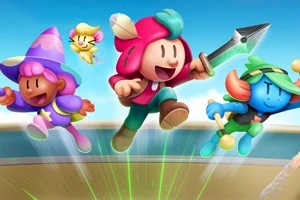Column: Geektique #1

Posted 12 May 2008 at 10:56 by Tom Phillips
Written by Ashley Boyd
Hello there loyal reader. I'm a 21 year old Media and Cultural Studies student, and I'm going to be performing a series of analyses applying the academic theories I have learnt... to the video games we all enjoy. First up, I'll be looking at the gender and sexuality of some of the characters.
While the application of Queer Theory, which, for the sake of clarification, applies to all forms of sexuality not just homosexuality, to characters within Nintendo's games may seem like an odd idea it is one that surprisingly generates a lot of discussion. One of the main arguments within this theory is that gender identity is fluid, and not fixed to either 'male' or 'female' which was theorised by Judith Butler. Two main characters stand out when looking at this theory; Birdo and Sheik. While those two will be focused upon, the theory will also be applied more generally to other characters.
When Nintendo decided to turn the Japanese game Yume Kojo: Doki Doki Panic into a new Mario Bros. game for the west, Super Mario Bros. 2, little did they know that one sub-boss, going by the name Birdo, would be one of their most genetically complex characters to translate. In the game's manual it is stated that: "He [Birdo] thinks he is a girl and he spits eggs from his mouth. He'd rather be called 'Birdetta." Despite other's claims to the contrary, this is the same in Japan as well (where Birdo is called Catherine).

To be fair, "Catherine" isn't exactly the most masculine of names...
So while Birdo seemed confused about its gender Nintendo seemed equally confused with how to deal with this unintentional controversy, and ultimately decided ignoring it is the best way to go and removed any references to Birdo's gender for some time. However, when Mario Strikers Charged was released in 2007 on the Wii, nineteen years later, Birdo's gender was once again questioned as the manual referred to Birdo, once more, as a "he." While Birdo had featured in games between these two this was the first time gender was mentioned, and once again it was male. However, in recent promotional art Birdo is seen wearing a large diamond ring. Although whether this reinforces the idea that Birdo is in fact female, or simply a male who wishes to be female, is open to person interpretation.
Some people claim that both the species and individual are called 'Birdo', (similar in case to Yoshi, or Toad). However, whether the commonly seen pink Birdo is a male wishing to be female or a female biologically is still unclear. Bornstein argues that gender fluidity offers individuals "the ability to freely and knowingly become one of many of a limitless number of genders for any length of time, at any rate of change." This could be seen in the case of Birdo, who seems to be switching between the two, albeit at Nintendo of America's discretion. Similarly, if you believe Butler's theory, Birdo's biological sex is unimportant. Whether Birdo is male or female, the performance they wish to give is what is important. So whether Birdo wants to spit eggs and be called "Birdette" or play a rousing game of tennis it doesn't matter, as it is up to Birdo which identity it chooses to use and whether this identity is physically either 'male' or 'female' is unimportant.

Sheik in Ocarina of Time. The character's appearance in Smash Bros. Brawl has a decidedly more feminine figure.
In 1998's ground-breaking The Legend of Zelda: The Ocarina of Time, Princess Zelda disguises herself as a male Sheikah, cleverly titled Sheik, to aid Link in his quest. Wearing a skin-tight blue outfit and scarf over his/her mouth to muffle his/her voice Zelda manages to completely transform her identity, and in turn gender. While it is presumed this is done through Zelda's sage magic, it could as easily be done without, albeit more difficult. More importantly, Zelda's usually more passive attitude, which could be argued to be a performance she puts on because she is after all royalty, is changed when she is Sheik. While she uses magic to help Link when they are escaping from Ganondorf she is secondary to Link's actions, however when she is Sheik she takes charge and she commands him around. This could be argued that gender is a performance, and Zelda chooses her dependant upon the context she is in.
However Sheik is, like Birdo, a source of contradiction and confusion. While in Ocarina, Sheik is revealed to be Zelda disguising herself as male, in the Super Smash Bros. series, this is contradicted by stating Sheik is a female, and giving Sheik a generally more feminine appearance which is contradicted again by the Ocarina of Time manga. One could argue that both the manga and the Smash Bros series are not canon, and as such the original Ocarina of Time statement that Zelda was disguising herself as male should be taken as fact. Greenwald, speaking about The Ballad of Little Jo, but could be applied to women in general, stated "she [Little Jo] passes through a phase to survive, ultimately to be a woman." In Zelda's case she has to take on the phase, that of a male, to survive her impending danger. However, she ultimately remains the woman she was before, but she is willing to break gender norms and use them for her own needs.

Peach has begun to be more than a stock 'damsel in distress' figure.
It is not just Birdo and Sheik who could be described as having fluid gender identities, many of the Nintendo characters also portray characteristics of fluid gender identity. Princess Peach on the surface appears to be the dainty damsel-in-distress, often under Bowser's capture, however beneath the surface lies a far more complex woman, one who portrays many traditional male characteristics. Peach proves herself to be as capable as anyone else in the various spin-off games she has appeared in. She has the brains and skills to win any Mario Party, and we all know she's got plenty strong enough knees and a pointy umbrella to help her beat Mario to a pulp in the Smash Bros. series. And whoever says women can't drive are proven wrong by Peach when she jumps in a kart.
Peach is not alone, other females in these games such as Daisy, Zelda and Toadette are just as capable to change between identities, as Peach's duel roles as the dainty lovable Princess and the sneaky go-karter shows, as Gauntlett argues, "Identity is a performance already � it's always a performance. The self is always being made and re-made in daily interactions." If you take Gauntlett's view to mind with Peach, as well as the other characters both male and female, is constantly choosing her performance based upon whatever they're up to that day, and they certainly get up to a lot of activities. Furthermore, Peach recently stared in her own game; Super Princess Peach. However, this again provides complexities, while she is taking action and rescuing Mario she gets her powers from her emotions. While this could be criticised as reinforcing gender norms Butler would argue that the fluidity of gender means she is free to chose how she wishes to act; be it through her emotions in Super Princess Peach or by beating Mario up, perhaps due to his lack of speed in rescuing her, in Brawl.
I am aware people may be critical of these points raised here. It would be easy to brush it off as just Nintendo cashing in on their characters, and simply including them as a fan-service. However, I would argue, that inclusion says as much as exclusion. Nintendo would not choose to include Peach in Smash Bros. if they felt it to be too implausible for her to conduct these activities, physically and otherwise.
Thanks for reading, and I hope it was interesting. Leave a comment below with your thoughts, and if you have any kind of personal feedback or particular ideas or arguments you wish for me to look at in the future, email them to me at: ashleytwo[at]googlemail.com
-Ashley Boyd,
N-Europe Staff Writer & Forum Admin






















